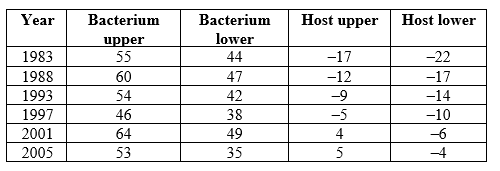Multiple Choice
Refer to the table. The table contains data on the effects of a symbiosis between a bee (host) and a bacterium over many years. The table shows the upper and lower bounds for the effects of the association; positive numbers denote net benefits and negative numbers denote net costs. (If zero is between the upper and lower bounds, consider the effect to be zero, since it is statistically indistinguishable from zero.) According to the table, the relationship between the fungus and the fly in 1988 was a
The table contains data on the effects of a symbiosis between a bee (host) and a bacterium over many years. The table shows the upper and lower bounds for the effects of the association; positive numbers denote net benefits and negative numbers denote net costs. (If zero is between the upper and lower bounds, consider the effect to be zero, since it is statistically indistinguishable from zero.) According to the table, the relationship between the fungus and the fly in 1988 was a
A) mutualism.
B) competitive interaction.
C) host‒parasite interaction.
D) commensalism.
Correct Answer:

Verified
Correct Answer:
Verified
Q43: Refer to the figure.<br><img src="https://d2lvgg3v3hfg70.cloudfront.net/TBO1115/.jpg" alt="Refer to
Q44: From the act of pollinating flowers, a
Q45: Refer to the figure.<br><img src="https://d2lvgg3v3hfg70.cloudfront.net/TBO1115/.jpg" alt="Refer to
Q46: Refer to the figure.<br><img src="https://d2lvgg3v3hfg70.cloudfront.net/TBO1115/.jpg" alt="Refer to
Q47: Refer to the figure.<br> <img src="https://d2lvgg3v3hfg70.cloudfront.net/TBO1115/.jpg" alt="Refer
Q49: In one interaction, a bird feeds on
Q50: A wasp pollinating a plant in exchange
Q51: Refer to the table.<br><img src="https://d2lvgg3v3hfg70.cloudfront.net/TBO1115/.jpg" alt="Refer to
Q52: Leaf-cutter ants are part of a complex
Q53: Refer to the figure.<br><img src="https://d2lvgg3v3hfg70.cloudfront.net/TBO1115/.jpg" alt="Refer to